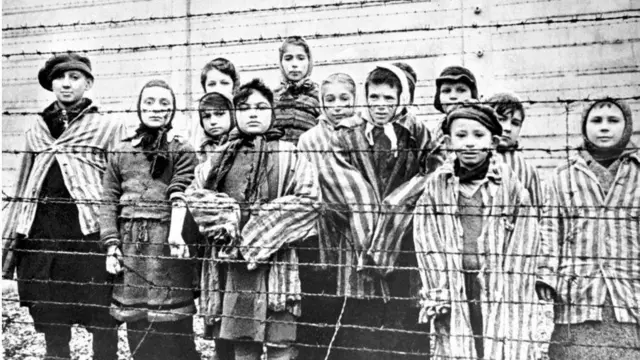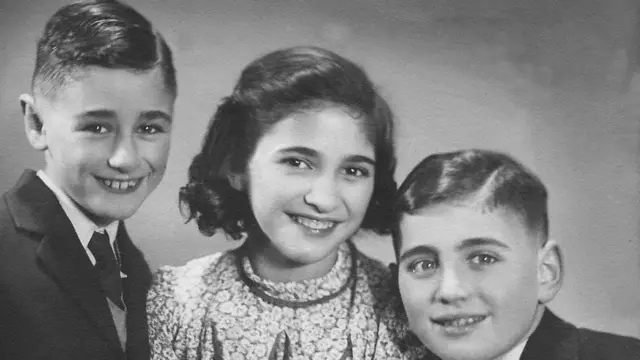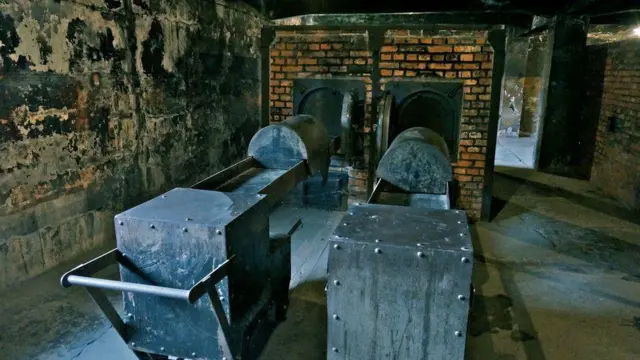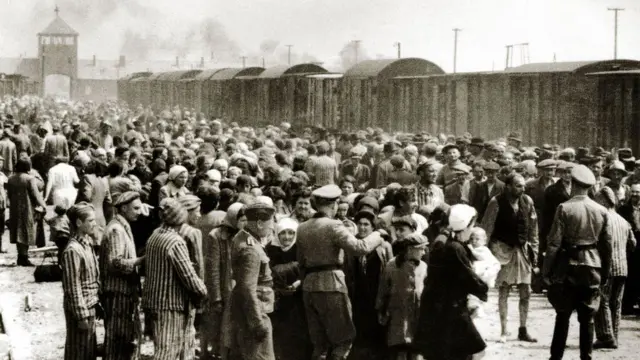Auschwitz: How death camp become centre of Nazi Holocaust - BBC News Pidgin

Wia dis foto come from, Getty Images
Na 80 years ago wey Soviet troops liberate di Nazi death camp for Auschwitz-Birkenau, and some of di last survivors go join some world leaders on 27 January to commemorate di 1.1 million pipo wey dem be murder for dia.
Di remaining survivors dey mostly in dia 90s now and dis fit be di last year any of dem fit attend.
In just over four-and-a-half years, Nazi Germany bin systematically murder at least 1.1 million pipo for Auschwitz, wey dem bin build for di south of occupied Poland near di town of Oswiecim.
Auschwitz bin dey for di centre of di Nazi campaign to wipe out Europe Jewish population, and almost one million of di pipo wey bin die for dia na Jews.
Among di odas wey lose dia lives na Poles, Roman and Russian prisoners of war.
By di time di Red Army bin cautiously enta Auschwitz on 27 January 1945, only about 7,000 prisoners bin remain. Tens of thousands of odas already bin dey forced to leave by trecking on "death marches" as di Nazis bin return to di west.
Italian prisoner Primo Levi bin dey lie down for camp hospital wit scarlet fever wen di Soviet liberators bin land.
Di men bin look dem "strangely wit embarrassed looks as dia body dey fail, for dia battered huts and few of us wey still dey alive", im go later write for im Holocaust memoir The Truce.
"Dem no greet us, dem no even smile; dem look oppressed not only by compassion but by... di feeling of guilt say such a crime dey exist."
"We bin see lean, tortured, impoverished pipo," na wetin soja Ivan Martynushkin tok about liberating di death camp, external. "We fit tell from dia eyes say dem bin dey happy as dem save dem from dis hell."
Wen di Nazis bin enta power for Germany in 1933 dem start to strip Jewish pipo of all dia property, freedoms and rights under di law.
After di German invasion and occupation of Poland in 1939, di Nazis bin start to deport Jewish pipo from di Third Reich to parts of Poland, wia dem bin create ghettos to separate dem from di rest of di population.
In 1941, during di German invasion of di USSR, di Nazis start dia campaign of extermination in seriously.
Nazis bin tok about dia invasion as a race war between Germany and Jewish pipo, as well as di Slavic population and di Roma.

Groups of German sojas wey dem bin call Einsatzgruppen bin set out across newly conquered lands for Eastern Europe to massacre civilians.
By di end of 1941, dem bin kill 500,000 pipo, and by 1945 dem murder about two million - 1.3 million na Jewish pipo.
Behind di lines, Nazi commanders bin dey experiment (test) ways to kill plenti pipo at once.
Dem bin dey fear say to shoot pipo too dey stressful for dia sojas, and so, dem bin come up wit more efficient means of murder.
Dem bin use gas vans as experiment to kill mentally disabled pipo for Poland as early as 1939.
Dem pump fumes wey dey poisonous into compartments wey dem lock to suffocate di pipo inside.
By di winter of 1941, di Nazis bin construct dia first gas chamber and crematorium (wia dem dey burn deadi body) for Auschwitz.
Nazi leaders bin meet for January 1942 for di Wannsee Conference to coordinate di industrial slaughter - wetin dem bin cal a "final solution to di Jewish question" - dem kill di entire European Jewish population, 11 million pipo by extermination and forced labour.
Bifor, Auschwitz na originally one Polish army barracks for southern Poland. Nazi Germany bin invade and occupy Poland for September 1939, and by May 1940 dem turn di site into jail for political prisoners.
Di Nazi officer wey dem bin make commandant of di concentration camp, Rudolf Höss, bring di motto Arbeit Macht Frei - works sets you free - from anoda camp wia im bin work, for Dachau in Germany.
Dat infamous lie still dey for dia till now, above di entrance to di camp wey pipo kon sabi as Auschwitz I.

As di war and di Holocaust bin progress, di Nazi regime bin expand di site well-well.
Di first pipo wey dem use gas on na a group of Polish and Soviet prisoners in September 1941.
Work start on a new camp, Auschwitz II-Birkenau, di following month. Dis come becom di site of di huge gas chambers wia dem bin murder hundreds of thousands bifor November 1944, and di crematoria wia dem burn dia bodies.
Birkenau bin suppose to become di biggest of six Nazi death camps. Dem complete three odas, for Belzec, Sobibor and Treblinka, in 1942.
Di first transport of Jews to Auschwitz II-Birkenau na 999 women and girls from Slovakia in March 1942.
Sharp-sharp deportations follow from France, and later di Netherlands and Belgium. By 1944, dem bin dey murder 12,000 Jews evriday.
German chemicals company IG Farben bin build and operate one synthetic rubber factory for Auschwitz III-Monowitz.
Oda private companies like Krupp and Siemens-Schuckert bin also run factories nearby, to use di prisoners as slave labour.
Both Primo Levi and Nobel Prize winner Elie Wiesel bin survive Monowitz concentration camp.
Wen Auschwitz bin eventually get freedom, e bin get more dan 40 camps and sub camps.
Dem bin pack pipo from all ova Europe into cattle wagons wey no get windows, toilets, seats or food, and transport dem to Auschwitz.
Na for dia dem separate pipo wey fit work and dos wey dem go immediately kill.
Dem order di pipo wey no fit work to go naked and sent dem to showers for "delousing" - a euphemism (term) wey dem dey use describe di gas chambers.

Wia dis foto come from, Getty Images

Wia dis foto come from, Getty Images
Guards from di so-called "Hygienic Institute" go drop powerful Zyklon-B gas pellets into di sealed chambers, and wait for pipo to die.
E bin dey take about 20 minutes. Di thick walls no go fit hide di screams of di pipo wey dey suffocate inside.
Den Sonderkommandos - oda prisoners, usually Jews wey dem bin force to work for di guards or be killed - go remove artificial limbs, glasses, hair and teeth bifor dem go drag di corpses to di incinerators (wia dem burn waste materials). Dem go burty di ashes of di deadibodies or use dem as fertiliser.
Dem go later carry properties of di pipo wey dem murder thru gas and di pipo wey dem send to work for sorting for one part of di camp known as "Canada" - dem name am like dat becos dem bin see Canada as a kontri of plenty.
SS guards bin try to hide dia crimes as Soviet troops bin close in, and try to destroy dia extensive prisoner records - wey make am hard to fully quantify di number of victims.
Academic studies since agree say di total dey close to 1.3 million pipo wey land for at Auschwitz. About 1.1 million of dem died dere..
Jews from all across Nazi-controlled Europe make up di vast majority of di victims. Almost one million Jewish pipo na im dem bin murder for Auschwitz.
One specific example na Hungary Jewish population. In di space of just two months, between May and July 1944, Hungary bin transport 420,000 of di 437,000 Jewish pipo dem bin send to Auschwitz.

Wia dis foto come from, Getty Images
Dem bin send tens of thousands of Hungarian Jews to Auschwitz evri day. Dem bin kill three quarter of dem on arrival.
Di German state for di Auschwitz complex bin also kill some 75,000 Polish civilians, 15,000 Soviet prisoners of war, 25,000 Roma and Sinti, as well as Jehovah's Witnesses, homosexuals and political prisoners.
German authorities bin give order make dem stop di gassing and dem begin destroy di gas chambers and crematoria in late 1944, as Soviet troops begin move westward.
Dem bin ship di stockpile of stolen valuables for di Canada sector to Germany shortly afterwards.
Becos dem bin dey determined to erase di evidence of dia crimes, di Nazis bin order 56,000 prisoners wey bin dey remian to march west to oda concentration camps, like Bergen-Belsen, Dachau and Sachsenhausen.
Dem leave di ones wey dey sick, wey no fit waka behind; and anyone wey fall behind as dem dey march dey go, dem go kill am.
Soviet forces see only a few thousand survivors wen dem bin enta di camp on 27 January 1945, along wit hundreds of thousands of clothes and several tonnes of human hair.
Sojas later remember say dem bin try to convince some survivors say di Nazis done finally go.
Elie Wiesel later tok for im speech to mark di 50th anniversary of di liberation, external say di Nazi crimes for Auschwitz "bin produce a mutation on a cosmic scale, wey dey affect man dreams and endeavours".
"After Auschwitz, di human condition no longer be di same. After Auschwitz, notin go ever be di same."











